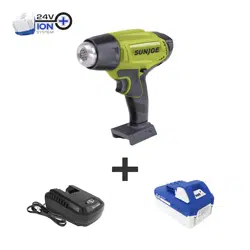Loading ...
Loading ...
Loading ...

11
mWARNING! DO NOT insert anything into the heat outlet.
1. Assemble the desired nozzle, insert the battery, and turn
on the heat gun as instructed above.
2. Hold the heat gun with one hand.
mWARNING! Do not place second hand on top of tool or
near the heat outlet at any time. Holding the tool on or near the
heat outlet can cause serious personal injury.
3. Move the heat gun until the nozzle is close to the area
being heated.
NOTE: Experiment with scrap materials to determine the
proper amount of heat, distance and time for your project.
4. During heating, move the tool back-and-forth. Avoid
lingering or pausing in one spot as this could overheat or
potentially ignite the material being heated.
5. Turn o the heat gun and remove the battery pack. Allow
the heat gun, the nozzle and the heated surface to cool
thoroughly.
Remove Paint
mWARNING! Refer to Safety Warnings for Removing
Paint with the Heat Gun in the Warning section before using
the tool to remove paint.
mWARNING! Do not strip paint on metal window frames
as the heat may crack the glass. When stripping paint on other
window frames, use a glass protector.
1. Attach the at nozzle. Insert the battery and turn on the
heat gun.
2. Direct hot air onto the paint to be removed. Best results
will be achieved if the heat gun is moved slowly, but
CONSTANTLY, from side to side to evenly distribute heat.
DO NOT LINGER OR PAUSE IN ONE SPOT.
3. When the paint softens, scrape the paint away using a
hand scraper.
NOTE: Splinters and small particles of stripped paint can
be ignited and blown through holes and cracks in the
surface being stripped.
Cool Down
The heat outlet and nozzle become very hot during use. Turn
o the heat gun, remove the battery and let the tool cool down
for at least 30 minutes before moving or storing it.
Maintenance
mWARNING! Before inspecting, cleaning, or servicing the
unit, stop the heat gun and remove the battery pack, wait for
the heat gun to cool. Failure to follow these instructions can
result in serious personal injury or property damage.
mWARNING! When servicing, use only identical
replacement parts. Use of any other parts could create a
hazard or cause product damage.
General Cleaning Tips
The heat gun should be kept clean, dry, and free of oil or
grease. Only a mild soap and damp cloth should be used to
clean the heat gun. Do not allow liquid to enter the tool.
The high temperatures of the heat gun will cause the heat
outlet to turn dark over time. This is normal and will not aect
its performance or life.
Air vents must be kept clean and free of foreign matter.
The most eective method of cleaning the vents is with
compressed air. Do not attempt to clean by inserting pointed
objects through the openings.
mWARNING! Avoid using solvents when cleaning plastic
parts. Most plastics are susceptible to damage from various
types of commercial solvents and may be damaged by their
use. Use clean cloths to remove dirt, dust, oil, grease, etc.
Storage
mWARNING! The heat outlet of the heat gun will stay
hot for a while after use. Always allow heat gun to cool before
storage. Following this rule will reduce the risk of serious
personal injury or property damage.
• Switch o and remove the battery. Cool down the unit.
Thoroughly clean the housing.
• Store the heat gun, with the battery and charger indoors in a
safe location out of the reach of children.
Disposal
Recycling the tool
• Do not dispose of electrical appliances as unsorted
municipal waste. Use separate collection facilities.
• Contact your local government agency for information
regarding the collection systems available.
• If electrical appliances are disposed of in landlls
or dumps, hazardous substances can leak into the
groundwater and get into the food chain, damaging your
health and well-being.
• When replacing old appliances with new ones, the retailer
is legally obligated to take back your old appliance for
disposal at least free of charge.
Recycling + Disposal
The product comes in a package that protects it against
damage during shipping. Keep the package until you are
sure that all parts have been delivered and the product is
functioning properly. Recycle the package afterwards or keep it
for long-term storage.
Loading ...
Loading ...
Loading ...
